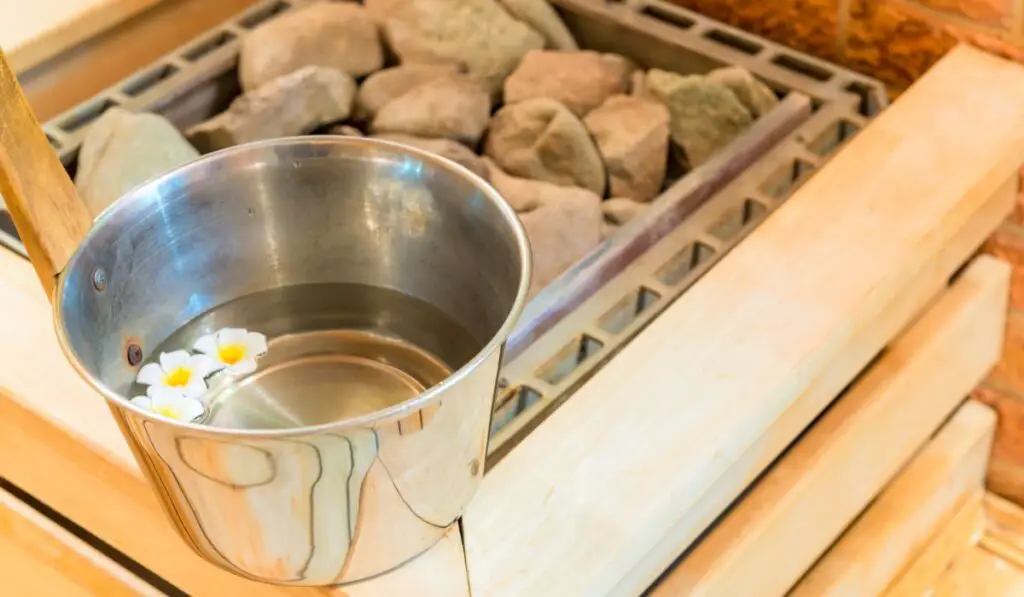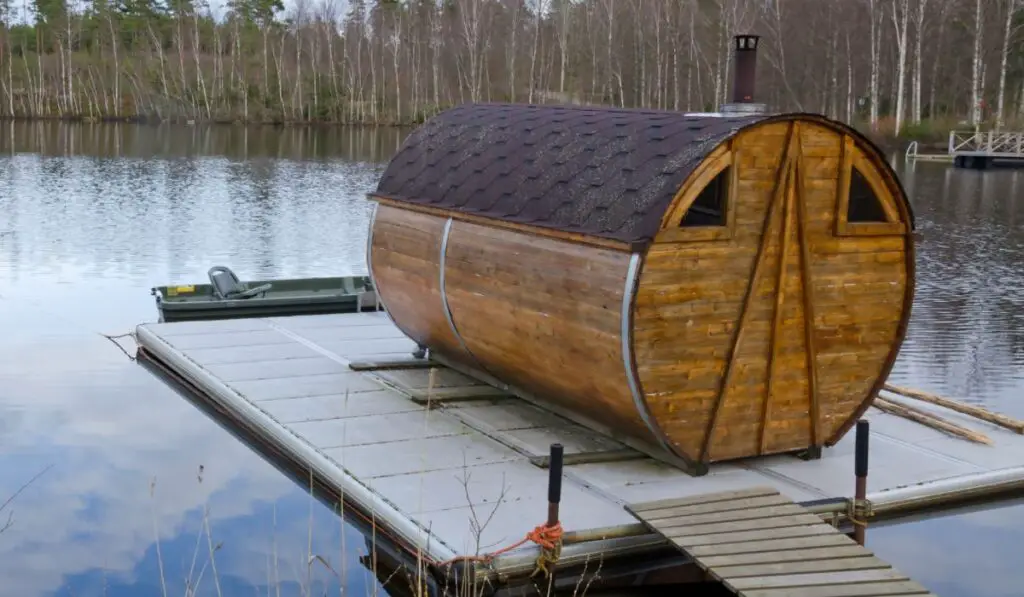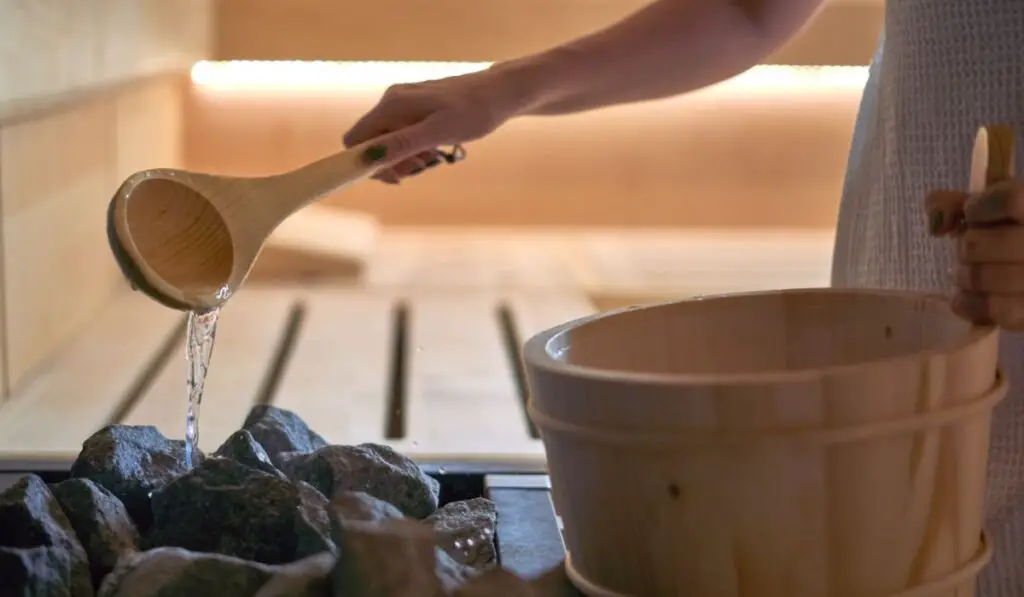There’s no question that saunas are very relaxing. If you found this article, chances are, you’re already aware of the benefits of regular sauna use. But if you accustom yourself to using your sauna as a dry-style sauna, what if you want to switch it up a little bit? Can you add water without any issues?
You can add water to a dry sauna, but not all dry saunas. If you have an electrical unit that utilizes rocks, you are most likely good to pour a few ladles of fresh water on. Just make sure to pour slowly. Other units are not compatible with water.
Adding water to your sauna can add another layer to your session. If you enjoy a little steam, it can be a great way to relax that has its own set of health benefits. Since most saunas have a design that allows for both use types, you should be able to experience a wet sauna with almost any dry unit. There are exceptions, and we’ll touch on those soon. Ready to learn about dry saunas and water? Read on!
What Do We Mean by “Dry Sauna”

When we say dry sauna, it might seem like a misnomer. Most saunas that we think about in popular culture have some element of steam in them. In fact, most traditional saunas utilize moisture in some way. But that doesn’t mean they always require moisture.
Humidity is a matter of choice and personal preference. Dry sauna sessions would be when you choose to omit the ladles of water on the hot sauna heater. Now, there are some dry saunas that don’t have any options for moisture. The first thing that comes to mind is a portable Infrared sauna. These just rely on dry heat, and you should consider them solely as dry saunas.
There are plenty of different types of saunas (our guide on this), and most of them have the option of being either a dry sauna or a wet sauna. Now, you might be thinking of commercial steam rooms, and, yes, they are specifically wet saunas as the steam is the source of the heat.
With dry saunas, it is said that you produce more sweat as you don’t benefit from the moisture on your skin helping the respiration process. This can help with some of the health benefits that some attach to sauna use.
How To Tell if You Have a Wet or Dry Sauna
There is a pretty simple way to determine if you have a wet or dry sauna. Ask yourself, where is the heat coming from? If it comes from a dry source, like coals or a modern electric unit. If it’s steam, then you can assume you have a wet sauna like this steam sauna (on Amazon).

Here is where things can go both ways. Most dry saunas are able to produce enough heat to instantly vaporize water. This means you can make a dry sauna into a wet sauna with some water poured over the heat source.
Now, this is not true for all types of saunas. A small minority will not be able to deal with the moisture, so always consult your user’s manual. Unfortunately, if steam is the heat source, you can’t make it a dry sauna. You’ll be stuck with the wet heat, which has its own benefits.
Are Wet or Dry Saunas Better?
When it comes to which is better, it’s really a matter of preference. While both can offer similar benefits like immune-boosting qualities and detoxification, each type has a slight advantage over the other. Let’s take a quick look at the pros and cons of each one.
Some of the biggest advantages of using a dry sauna is the fact that it helps produce more sweat, you may have a better effect on the immune system, and it has been argued that it helps enhance the detoxification process. On the other hand, the dry sauna cons are that the dry heat can be bad for your throat and respiratory system and it’s fairly easy to become dehydrated.
Regarding the wet sauna, they can be great for ailments like colds and asthma, it helps with respiratory illnesses from humidity exposure and can relieve sinus stress and pressure. The biggest con is also its greatness, in the sense that all of that extra humidity can reduce benefits from the heat.
Can You Add Water To A Dry Sauna?
So, you’re looking to add a bit of moisture to your sauna session. Adding humidity can drastically change the overall experience and can add some significant health benefits. But how can you do this if you’ve got a dry sauna? The truth is you might be able to use your existing hardware and just add a bit of moisture without too much of a hassle.
Depending on the type of heating unit you have, you might be able to add water without needing any additional equipment. If you are using an IR sauna, however, you won’t be able to add humidity. Most other sauna heating sources, like wood or even electric heaters, have the capacity for you to use them with water if you want to.
This all comes back to the fact that the heating source itself is going to be very hot. A few ladles of water would only vaporize in a quick puff of water vapor. As long as you are conservative with the amount, you shouldn’t have any worries next time you feel like your sauna could use a little steam. Always check with the manufacturer of the sauna or the heating source before you start ladling water, though.
While dry saunas are useful, most sauna you see have the capacity to be a mixture of both. Having a heating unit that can handle a bit of water means that you can use the device as both a wet and a dry sauna. But what if you have sauna rocks?
Can You Pour Water Over Hot Sauna Rocks
If you are using a sauna heater with sauna rocks, you might be wondering if you can use water. Much like the heating sources we touched on above, most units that utilize rocks as part of the heat source should be fine with a little bit of water (more on sauna rocks in our guide).

The idea here is that the rocks act as indirect heat sources away from the electrical unit. Consequently, you should be able to use water with this type of sauna. You can pour water on sauna rocks like these ones (on Amazon). The purpose of the rocks is to allow for electrical units the option of adding humidity.
This is certainly not true for all saunas with sauna rock, but certainly for most of them. There may be a few units that use rocks that are mainly for aesthetic qualities, but this will be quite rare. The trick with using sauna rocks is not to drown the unit. You never want to go overboard with the ladles of water.
In fact, be conservative with the amount. If you don’t, you might risk ruining the entire unit. Many sauna users will have a pouring device that will allow them to drizzle water over the hot rocks evenly. This makes sure that the unit can vaporize all the water before it has time to sneak past the rocks into the inner workings of the unit.
Will Adding Water Make My Sauna Hotter?
Every time you use a sauna, you jumpstart your body’s perspiration response. We call this sweating. You are constantly trying to maintain your core body temperature and releasing sweat to keep your skin cool. Skin is the largest organ in the human body and plays an essential role in cooling us down and expelling toxins. This is what you are trying to achieve when using a sauna.
But why does a wet sauna feel hotter? It has a lot to do with this process. When you opt for a wet sauna, it means your body isn’t producing as much sweat. Why? Well, part of what cools us down during the sweating process is evaporation. When the sweat on our skin evaporates, it creates a cooling effect that reduces the surface temperature.
When you add water to your sauna, you are keeping the sweat on your skin from evaporating. For sweat to properly cool, it needs the ambient atmosphere to dry. The more humid the air is, the less efficient the body’s cooling system performs.
That’s exactly why it always feels hotter on a humid day. Even if it’s only 78°F outside, a 100% humidity level will make it feel like it’s upward of 90°F +. The conditions in your sauna certainly aren’t different. Humid air feels thicker and makes the perspiration process difficult. This is why some people prefer the dry sauna experience. It means they sweat more and feel less like they are swimming in the humidity.
Wrapping Up
If you have a dry sauna, chances are you can easily add water, although, this does not hold true for all sauna types. If you have an IR sauna, you probably can’t get away with adding any moisture. Other sauna types, though, can handle a bit of water with no problem.
If you have a fire-style sauna, or even an electrician unit with sauna rocks, adding a few ladles of freshwater every once in a while is more than fine. In fact, manufacturers will usually design these systems to be able to handle moisture. Adding humidity is part of the traditional sauna experience. If you have any questions, make sure to check out the owner’s manual for your sauna’s heat source.
